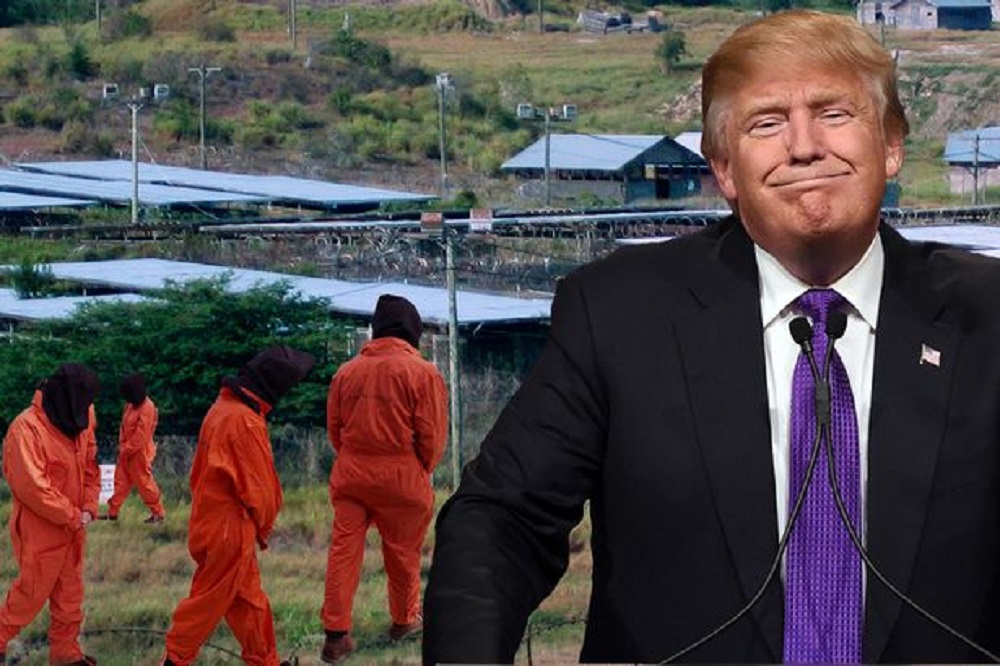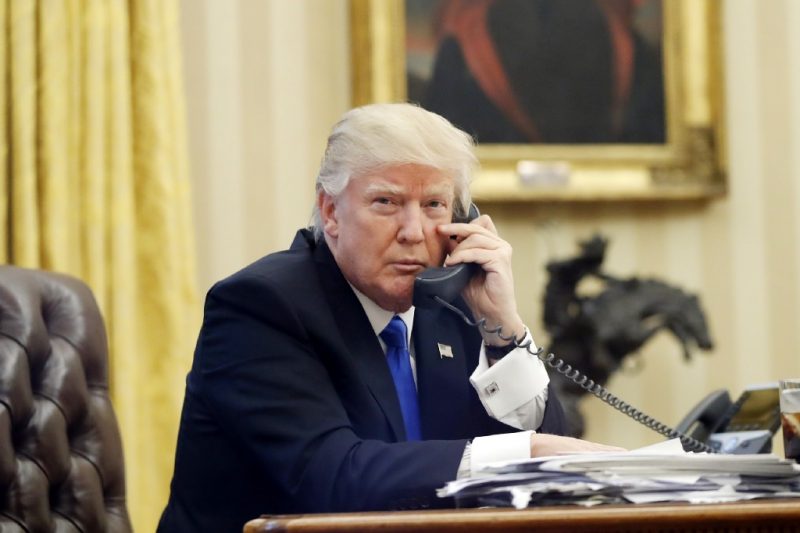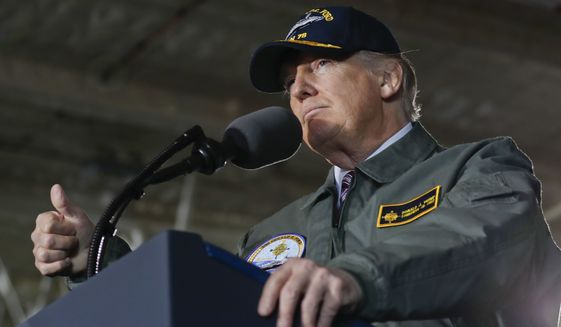
President Donald Trump has truly got a thing for former President Barack Obama which hit hard on Saturday with his Twitter tantrum filled with false accusations, but he continued on Tuesday with more false information.
Unlike Saturday’s rant, it’s still not clear where Trump got his information that set him into a tizzy, but with his Guantanamo Bay misinformation, we know it came straight from Fox & Friends. They didn’t get their information wrong, he just took those facts and created a falsehood with it. Imagine, the man who hates ‘fake news‘ has been creating plenty of it in less than a week.
Being the president and having so much power, you would think after Saturday, Trump would just pick up the phone and contact his intel world for some accuracy, but he seems more content relying on media sources.
Former Gitmo detainee killed by a U.S. airstrike in Yemen; at least 122 former Gitmo detainees have re-engaged in terrorism pic.twitter.com/y9jb420fFZ
— FOX & friends (@foxandfriends) March 7, 2017
122 vicious prisoners, released by the Obama Administration from Gitmo, have returned to the battlefield. Just another terrible decision!
— Donald J. Trump (@realDonaldTrump) March 7, 2017
Wrong POTUS, @realDonaldTrump. Your intel agencies report shows Bush released 113 of the 122 re-engagers from Gitmo. https://t.co/AvYSHDspfl pic.twitter.com/YZOVOrJS3O
— Carol Rosenberg (@carolrosenberg) March 7, 2017
The other thing he got wrong last week when he visited the Gerald R. Ford aircraft carrier was all those comments about our military being so depleted. You would think that we had become a third world country with the words he chose, but we’ve got those facts all cleared up for you below.
President Donald Trump targeted the wrong president Tuesday when he criticized the Obama administration for releasing “122 vicious prisoners” from the Guantanamo Bay detention center who later resumed militant activities.
The latest report from the office of the director of national intelligence shows that 122 men who were held at the U.S. base in Cuba are confirmed to have re-engaged in hostilities after they were released. But more than 90 percent of those were released by President George W. Bush, the report says.
Every six months, the DNI is required by law to publish statistics on the number of former Guantanamo prisoners either confirmed or suspected of recidivism, a response to congressional fears that potentially dangerous terrorists would be released amid efforts to close the detention center.
Trump said during last year’s presidential campaign that he wants the detention center, often referred to as “Gitmo,” to be kept open. At one point, he pledged to “load it up with some bad dudes.”
On Tuesday, he said on Twitter that “122 vicious prisoners, released by the Obama Administration from Gitmo, have returned to the battlefield. Just another terrible decision!”
But his statement lumped together the prisoners who were released under Bush and Obama and were later determined to have resumed some association with al-Qaida, the Taliban or some other militant group.
The U.S. opened the detention center on the base in January 2002 to hold and interrogate suspected enemy combatants. At its height in July 2003 it held about 680 prisoners. Over time, a total of nearly 800 passed through the facility.
Most of the releases occurred under Bush, who ultimately agreed the detention center should close. His administration freed 540, sometimes dozens at a time, to countries around the world.
The latest DNI report, from September, concludes that 122 detainees re-engaged in fighting but 113 of them had been released before Obama took office in January 2009. It said an additional 86 detainees are “suspected” of militant activities – again, nearly all freed under Bush.
Lawyers and other advocates for prisoners have disputed the description of men “returning” to the battlefield, arguing that at least some may never have been fighting the U.S. in the first place and could have been radicalized at Guantanamo.
As it sought to close the detention center, the Obama administration tried to minimize the recidivism problem through a “rigorous interagency review process” and parole-style hearings. The administration ultimately failed to close the center, though, because it deemed some detainees not releasable and Congress prohibited moving any of them to the U.S. for any reason. Today there are 41 men left.
President Donald Trump painted an overly bleak picture of the condition of the armed forces Thursday as he made his case for military expansion.
A look at some of his statements from the Gerald R. Ford, a $12.9 billion aircraft carrier being built in Newport News, Virginia:
TRUMP: “We are going to have very soon the finest equipment in the world.”
THE FACTS: Pentagon leaders have said for years that the U.S. already has the world’s best weaponry and military equipment. They sometimes claim the U.S. is in danger of losing its advantage unless the Congress continues to spend heavily to develop and build new generations of weapons.
The Navy’s top officer, Adm. John Richardson, has said repeatedly that the Navy is the world’s finest. He also has said the Navy must adapt to a world of changing security threats. Richardson’s main focus has been on sharpening and changing the way sailors think about the nature of war, rather than relying on bigger budgets.
“We will not be able to ‘buy’ our way out of the challenges that we face,” he wrote in a January 2016 plan for maintaining U.S. naval superiority.
TRUMP: “This great aircraft carrier provides essential capabilities to keep us safe from terrorism and take the fight to the enemy for many years in the future.”
THE FACTS: Aircraft carriers are not the crucial element in the defense against terrorism. They do provide a flexible means of bringing warplanes and intelligence-gathering aircraft to areas where terrorists are being hunted, like off the coast of Libya or in the Persian Gulf, but their main function is to deter bigger wars with state powers like China, Russia and North Korea. The Pentagon’s counterterrorism campaigns rely more on special operations forces, Air Force fighters and surveillance drones, military trainers and advisers and the intelligence agencies.
TRUMP: “I am calling for one of the largest defense spending increases in history.”
THE FACTS: Three times in recent years, Congress raised military spending by larger amounts, in percentage terms, than the $54 billion, or 10 percent, increase that Trump proposes. The base defense budget grew by $41 billion, or 14.3 percent, in 2002; by $37 billion, or 11.3 percent, in 2003, and by $47 billion, or 10.9 percent, in 2008, according to Defense Department figures.
The proposed expansion pales in comparison with skyrocketing increases in earlier times. Military spending consumed 43 percent of the economy in 1944, during World War II, and 15 percent in 1952, during the Korean War. It was 3.3 percent in 2015, says the World Bank.
TRUMP: “Our Navy is now the smallest it’s been since, believe or not, World War I. Don’t worry. It’s going to soon be the largest it’s been.”
THE FACTS: No, the fleet is not growing to the largest it’s been, or anything close.
The fleet indeed shrank to its smallest size since the decade after World War I — bottoming out at 271 in 2015 before rising to 274 this year, compared with 139 in 1930. But that number alone is not that meaningful.
The nature of warfare has changed since the naval battles of the world wars — the rise of air power being just one significant factor. As well, for the last few decades the Navy has dramatically increased the warfighting effectiveness of its ships, meaning it can do more with far fewer vessels than it could during the Cold War, for example.
The fleet stood at a record high of 6,768 fighting ships during World War II, declined gradually in the 1950s and ’60s and shrank significantly after the Vietnam War. During the 1990s the number fell from the high 500s to the mid-300s as the Navy decommissioned many older ships and the U.S. reaped a “peace dividend” from the end of the Cold War. The count includes aircraft carriers, cruisers, destroyers, submarines, amphibious assault ships and other large combat ships.
The fleet may grow more than planned if Trump’s military expansion is approved by Congress. But no one is talking about matching — much less exceeding — the enormous armada of another age.
The number of Navy personnel has also fallen over time, from more than 725,000 in 1954 to about 323,000 now. It’s unlikely to grow anywhere near that higher level.



